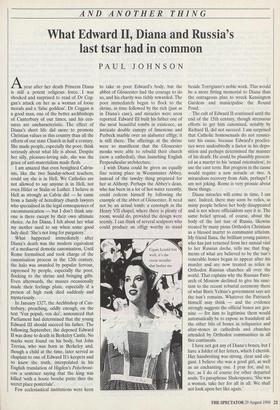AND ANOTHER THING
What Edward II, Diana and Russia's last tsar had in common
PAUL JOHNSON
I am amazed that even benighted Calvin- ists, like the two Sunday-school teachers, could say she is in Hell. We Catholics are not allowed to say anyone is in Hell, not even Hitler or Stalin or Luther. I believe in Hell as strongly as Calvin did — he came from a family of hereditary church lawyers who specialised in the legal consequences of excommunication — but I don't think any- one is there except by their own ultimate choice. As for Diana, I felt about her what my mother used to say when some good lady died: 'She's not long for purgatory.'
What happened immediately after Diana's death was the modern equivalent of a mediaeval demotic canonisation. Until Rome formalised and took charge of the canonisation process in the 12th century, the halo was awarded by popular fervour, expressed by people, especially the poor, flocking to the shrine and bringing gifts. Even afterwards, the masses occasionally made their feelings plain, especially if a person of high rank died suddenly and mysteriously.
In January 1327, the Archbishop of Can- terbury, preaching, oddly enough, on the text `Vox populi, vox dei', announced that Parliament had determined that the young Edward III should succeed his father. The following September, the deposed Edward II was done to death in Berkeley Castle. No marks were found on his body, but John Trevisa, who was born in Berkeley and, though a child at the time, later served as chaplain to one of Edward II's keepers and so knew the truth, interpolated in his English translation of Higden's Polychroni- con a sentence saying that the king was killed 'with a hoote broche putte thro the secret place posteriale'.
Few ecclesiastical institutions were keen to take in poor Edward's body, but the abbot of Gloucester had the courage to do so, and his charity was richly rewarded. The poor immediately began to flock to the shrine, in time followed by the rich (just as in Diana's case), and miracles were soon reported. Edward III built his father one of the most beautiful tombs in existence, an intricate double canopy of limestone and Purbeck marble over an alabaster effigy; it is still there. The offerings at the shrine were so munificent that the Gloucester monks were able to rebuild their church (now a cathedral), thus launching English Perpendicular architecture.
I wish Diana could be given an equally fine resting place in Westminster Abbey, instead of the tawdry thing prepared for her at Althorp. Perhaps the Abbey's dean, who has been in a lot of hot water recently, could redeem himself by following the example of the abbot of Gloucester. It need not be an actual tomb: a cenotaph in the Henry VII chapel, where there is plenty of room, would do, provided the design were seemly. I can think of several sculptors who could produce an effigy worthy to stand beside Torrigiano's noble work. This would be a more fitting memorial to Diana than the outrageous plan to wreck Kensington Gardens and municipalise the Round Pond.
The cult of Edward II continued until the end of the 15th century, though strenuous efforts to get him canonised, notably by Richard II, did not succeed. I am surprised that Catholic homosexuals do not resusci- tate his cause, because Edward's proclivi- ties were undoubtedly a factor in his depo- sition and perhaps determined the manner of his death. He could be plausibly present- ed as a martyr to his 'sexual orientation', to use the cant term. But progress in the cause would require a new miracle or two. A miraculous recovery from Aids, perhaps? I am not joking. Rome is very prosaic about these things.
Diana miracles will come in time, I am sure. Indeed, there may soon be relics, as many people believe her body disappeared and is not where officialdom says it is. The same belief spread, of course, about the body of the last tsar of Russia, likewise treated by many pious Orthodox Christians as a blessed martyr to communist atheism. My friend Ilana, the brilliant young painter, who has just returned from her annual visit to her Russian dacha, tells me that frag- ments of what are believed to be the tsar's venerable bones began to appear after his murder and are now treated as relics in Orthodox Russian churches all over the world. That explains why the Russian Patri- arch of Moscow declined to give his sanc- tion to the recent reburial ceremony there of what Boris Yeltsin's government says are the tsar's remains. Whatever the Patriarch himself may think — and the evidence strongly suggests the official bones are gen- uine — for him to legitimise them would automatically be to expose as fraudulent all the other bits of bones in reliquaries and altar-stones in cathedrals and churches attended by Orthodox communities in all five continents.
I have not got any of Diana's bones, but I have a folder of her letters, which I cherish. Her handwriting was strong, clear and ele- gant. I believe she was a good girl, as well as an enchanting one. I pray for, and to, her, as I do of course for other departed souls. To paraphrase Shakespeare, 'She was a woman, take her for all in all. We shall not look upon her like again.'


























































 Previous page
Previous page